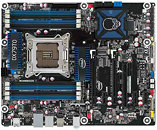- Joined
- Oct 9, 2007
- Messages
- 47,511 (7.48/day)
- Location
- Hyderabad, India
| System Name | RBMK-1000 |
|---|---|
| Processor | AMD Ryzen 7 5700G |
| Motherboard | ASUS ROG Strix B450-E Gaming |
| Cooling | DeepCool Gammax L240 V2 |
| Memory | 2x 8GB G.Skill Sniper X |
| Video Card(s) | Palit GeForce RTX 2080 SUPER GameRock |
| Storage | Western Digital Black NVMe 512GB |
| Display(s) | BenQ 1440p 60 Hz 27-inch |
| Case | Corsair Carbide 100R |
| Audio Device(s) | ASUS SupremeFX S1220A |
| Power Supply | Cooler Master MWE Gold 650W |
| Mouse | ASUS ROG Strix Impact |
| Keyboard | Gamdias Hermes E2 |
| Software | Windows 11 Pro |
Intel's Desktop Board division didn't miss out on the Sandy Bridge-E LGA2011 platform launch, after all, it's ceremonial for Intel to launch a new generation of processors with its own branded motherboards that are fully compatible with them. While Intel had two models of LGA2011 motherboards in the pipeline, the DX79SI and DX79TO, only the former was launched in November, which made it to most platform reviewers. The DX79SI was launched at a price point of US $289 - $299 MSRP, though some retailers easily set that price above $300. The new DX79TO is designed to be a down-scaled version of the DX79SI, targeting a price range of $203 - $208, according to ARK. Naturally then, the price that's 30% lower than that of the DX79SI invites some aggressive feature-cutting.
To begin with, the DX79TO could have a slightly slimmer CPU VRM. Thankfully, it doesn't cheap out much on VRM heatsinks, with the same exact ones found on the DX79SI. The heatsink cooling the VRM area south of the socket is not linked to the PCH heatsink with a heat-pipe, like on the DX79SI. The PCH heatsink itself looks slightly slimmer, though it's not a major area of concern. The CPU socket is still wired to as many as eight DDR3 DIMM slots, supporting up to 64 GB of quad-channel DDR3 memory.

Let the cost cutting begin. First, the expansion slot area does away with the third PCI-Express 3.0 x16 (x8) slot, it is reduced to a PCIe x1. The board is left with two PCI-Express 3.0 x16 slots wired to the CPU, one legacy PCI, and three PCIe x1. Next up, the 8-channel HD audio cluster is replaced by a 6-channel one (pray why? even $50 motherboards have 8-channel audio these days!). Optical SPDIF output is gone. The board has just one GbE connection, the DX79SI has two. Thankfully this connection is still driven by an Intel-made controller. There is just one USB 3.0 controller, which handles the two USB 3.0 ports on the rear panel. The front-panel USB 3.0 controller and its headers are blanked, so two USB 3.0 ports are all you get with this board. In all, Intel did some very aggressive cost cutting, which makes the DX79TO a board for those who'll run Sandy Bridge-E at bare-minimum stock settings. It is DX58OG, encore.
View at TechPowerUp Main Site
To begin with, the DX79TO could have a slightly slimmer CPU VRM. Thankfully, it doesn't cheap out much on VRM heatsinks, with the same exact ones found on the DX79SI. The heatsink cooling the VRM area south of the socket is not linked to the PCH heatsink with a heat-pipe, like on the DX79SI. The PCH heatsink itself looks slightly slimmer, though it's not a major area of concern. The CPU socket is still wired to as many as eight DDR3 DIMM slots, supporting up to 64 GB of quad-channel DDR3 memory.

Let the cost cutting begin. First, the expansion slot area does away with the third PCI-Express 3.0 x16 (x8) slot, it is reduced to a PCIe x1. The board is left with two PCI-Express 3.0 x16 slots wired to the CPU, one legacy PCI, and three PCIe x1. Next up, the 8-channel HD audio cluster is replaced by a 6-channel one (pray why? even $50 motherboards have 8-channel audio these days!). Optical SPDIF output is gone. The board has just one GbE connection, the DX79SI has two. Thankfully this connection is still driven by an Intel-made controller. There is just one USB 3.0 controller, which handles the two USB 3.0 ports on the rear panel. The front-panel USB 3.0 controller and its headers are blanked, so two USB 3.0 ports are all you get with this board. In all, Intel did some very aggressive cost cutting, which makes the DX79TO a board for those who'll run Sandy Bridge-E at bare-minimum stock settings. It is DX58OG, encore.
View at TechPowerUp Main Site
Last edited:




